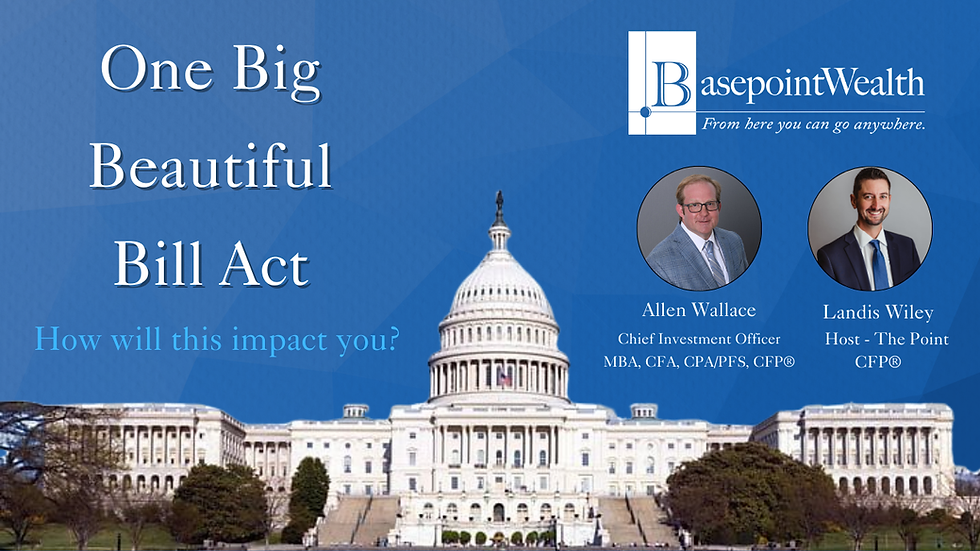Principle 1: Contrast Investment Versus Speculation
- W. Allen Wallace

- Oct 6, 2017
- 5 min read
Updated: Aug 26
Our first principle is carefully contrasting investment versus speculation and being very deliberate in avoiding the latter. In our estimation, avoiding mistakes is much more important to your success than outguessing the competition regarding short-term security price fluctuations.

Dear Family, Friends, and Clients:
Establishing enduring principles that stand the test of time is no easy matter. We must delicately distill the signal from the noise, and be certain that our conclusions are not shaped by popular opinion or current events. Our principles are not simple formulas that will bring you success overnight; we do think, however, the processes that our principles lead to will bring you success over long periods of time. At times our principles will seem clearly correct, at other times they may appear to be out-of-step with the current market; it is during these times, that they are most important.
Our first principle is carefully contrasting investment versus speculation and being very deliberate in avoiding the latter. In our estimation, avoiding mistakes is much more important to your success than outguessing the competition regarding short-term security price fluctuations. While this statement has a nice ring to it, it is based on years of research and changing popular opinions through both good and poor investment climates. Its importance resides in the protection provided by minimizing permanent losses, providing confidence in the knowledge that our securities are soundly selected, and increasing the probability of good results over long periods of time, no matter what market follies we must navigate. During periods of market volatility, owning securities tethered to reality gives us the confidence, in the words of FDR, to “convert retreat into advance”.
The conversation on the differentiation between investment and speculation goes back to at least 1911 when Lawrence Chamberlain said in his book, Principles of Bond Investing, “…the fact remains that every class of pure investment, such as bonds and mortgages and bank deposits, is safer than any class of speculation, such as stocks, real estate, and commodities. In fine, therefore, the perfect investment is a promise to pay; it is always a loan.[2]” In those days it was very clear: bonds are for investors and stocks are for speculators. The distinction was purely a matter of certainty. The author’s opinion was no doubt shaped by the twin stock market panics of 1907 and 1910-11.*
Just 13 years later in 1924, at the dawn of a spectacular bull market in stocks, Edgar Lawrence Smith was not so sure when he wrote “Because common stocks are regarded as speculative, they are frequently omitted entirely from the lists of a great many investors. Is this omission based on a thorough study of the relative merits of bonds and stocks or is it based in part on prejudice?[3]” The Dow Jones would soar 500% from this point, culminating in a devastating stock market crash on October 29, 1929, and leading into an economic depression that shaped an entire generation. Perhaps simple classification was not enough to differentiate.
In 1938 John Burr Williams set out to answer the question of what an investment is worth in his book “The Theory of Investment Value.” Although written in the middle of a depression, his contrast of investment and speculation was much more measured than some of his predecessors, when he said in the first chapter, “…we shall define an investor as a buyer interested in dividends, or coupons and principal, and a speculator as a buyer interested in the resale price.[4]” It seems that the rub was no longer in classification (stocks vs. bonds) but in the intent of the purchaser. While this is an advancement in the conversation, it is still subject to changes in taste and popular convention.
Taking a small step back to 1934, a Columbia Professor named Benjamin Graham made an attempt to formalize and professionalize the analysis of securities in his text book, Security Analysis. His logical and thoughtful approach to separating enduring principles from popular opinion have made his philosophies timeless, and a guiding light to all who enjoy their glow. While it is simple to intuitively differentiate between investment and speculation, upon thorough analysis it is definitely not easy. The root of the divide, according to Graham, was not wholly in classification (bond vs. stock), method (cash or margin) or intent (long-term or short-term), or even in the obvious factors of “safety vs. risk” or “income vs. profit”. The crux of the matter is whether the combination of all of these factors, upon thorough analysis, is likely to produce satisfactory results over time.
Graham was clear to point out that “an investment operation is one that can be justified on both qualitative and quantitative grounds.[1]” The reason that this is revolutionary, is that it no longer attempts to broadly classify the distinction as clearly delineated into intuitive rules of thumb. It takes analysis to separate investment from speculation, and it is the “operation” that is analyzed, not the purchaser or the security. Furthermore, Graham states, “investment is grounded in the past and speculation looks into the future.[1]” It becomes clear that investing depends on a protective mechanism guarding against the future, whereas speculation depends on hope that the future is to be profited from.
Our commitment is to thoughtfully and prudently invest your assets in securities that are likely to generate satisfactory returns based on thorough analysis. This is not a promise to eliminate price volatility, but it is an agreement that we will work hard to identify securities and funds that earn their returns through measurable fundamentals, not solely through price fluctuations, and the need for a future buyer to be willing to pay more than we did, based purely on hope. By following this principle, we will increase your probability of success, and hopefully provide the dual ability for you to eat well and sleep well.
We continue to progress on our transition. This would have been an impossible task without our stakeholders. We are excited about our new capabilities and we look forward to continuing to execute on our mission to help you reach your definition of success.
Warm Regards,
Allen
W. Allen Wallace Chief Investment Officer
*The very first mention of speculation that I have found was written in 1688 by Joseph de la Vega in his book, Confusión de Confusiónes (Confusion of Confusions). “…it should be observed that three classes of men are to be distinguished on the stock exchange. The princes of business belong to the first class, the merchants to the second, and the speculators to the last.[5]” Even 329 years ago, prudent men warned against the dangers of speculation.
CITATIONS
Graham, B., & Dodd, D. (1934). Security Analysis. New York: McGraw-Hill.
Chamberlain, L. (1911). Principles of Bond Investment (Fourth ed.). Henry Holt and Company.
Smith, E. L. (1924). Common Stocks as Long-term Investments. New York: Macmillan.
Burr, J. W. (1938). The Theory of Investment Value. Cambridge, MA: Harvard University Press.
Vega, J. D. (1957). Confusión de Confusiones: Amsterdam, 1688 (Kress Library of Business and Economics, Ed.). Boston, MA: Harvard Graduate School of Business Administration.




Comments